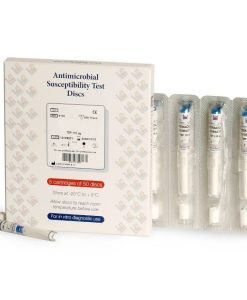Cromatest Glucose MR Reagent for Bio Chemistry Analyzer for Reliable RBS Test
৳ 1,800৳ 2,000 (-10%)
In stock
Cromatest Glucose MR Reagent for Bio Chemistry Analyzer for Reliable RBS
Packaging Size: (4x 100) ml
Origin: Spain
Brand : Cromatest / Linear
Packaging Type: Bottle
Test/Pack: 100 Test
Method: CNPG3. Kinetic
Cromatest Glucose MR Reagent for Bio Chemistry Analyzer for Reliable RBS Test
Applications: Diagnostic
Format: Liquid
Tested Parameter: For Transferrin
Storage temperature :Min.: 2 °C (36 °F) – Max.: 8 °C (46 °F)

PRINCIPLE
In the Trinder reaction1,2, the glucose is oxidized to D-gluconate by the glucose oxidase (GOD) with the formation of hydrogen peroxide. In the presence of peroxidase (POD), a mixture of phenol and 4-aminoantipyrine (4-AA) is oxidized by hydrogen peroxide, to form a red quinoneimine dye proportional to the concentration of glucose in the sample.

REAGENT COMPOSITION
R1- Monoreagent. Phosphate buffer 100 mmol/L pH 7.5, glucose oxidase > 10 KU/L, peroxidase > 2 KU/L, 4- aminoantipyrine 0.5 mmol/L, phenol 5 mmol/L.
CAL: Glucose standard. Glucose 100 mg/dL (5.55 mmol/L). Organic matrix based primary standard. Traceable to SRM 914a and 909.STORAGE AND STABILITY
STORAGE AND STABILITY
Store at 2-8ºC.
The Monoreagent and Standard are stable until the expiry date stated on the label. Discard the reagent if presents an absorbance over 0.300 at 500 nm against distilled water or if it fails to recover the declared values of control sera. .
REAGENT PREPARATION
The Monoreagent and the Standard are ready-to-use.
SAMPLES
Serum or heparin plasma free of hemolysis. Glucose is stable up to 24 hours at 2-8ºC when serum or plasma is separated within 30 minutes after collection
INTERFERENCES
- Highly icteric or lipemic samples require a blank correction. Use the same volume of sample with isotonic saline in the place of the
- Several interfering compounds have been 3,4
MATERIALS REQUIRED
- Photometer or colorimeter capable of measuring absorbance at 500 ± 20 nm.
- Constant temperature incubator set at 37ºC.
- Pipettes to measure reagent and
PROCEDURE
- Bring reagents and samples to room
- Pipette into labelled tubes:
|
- Mix and let stand the tubes 10 minutes at room temperature or 5 minutes at 37ºC.
- Read the absorbance (A) of the samples and the standard at 500 nm against the reagent
The color is stable for about 2 hours protected from light.
CALCULATIONS
Samples with concentrations higher than 500 mg/dL should be diluted 1:4 with saline and assayed again. Multiply the results by 4. If results are to be expressed as SI units apply: mg/dL x 0.0555 = mmol/L
REFERENCE VALUES5
Serum, plasma (fasting)
|
It is recommended that each laboratory establishes its own reference range.
QUALITY CONTROL
The use of a standard to calculate results allows to obtain an accuracy independent of the system or instrument used.
To ensure adequate quality control (QC), each run should include a set of controls (normal and abnormal) with assayed values handled as unknowns.
CLINICAL SIGNIFICANCE
Glucose is a major energy source for the human body, derived from the breakdown of carbohydrates obtained from daily diet and regulated through the process of glycogenolysis (breakdown of body stored glycogen), and gluconeogenesis (endogenous synthesis from aminoacids and other substances).
The glucose level in the blood is maintained by diet uptake and regulatory hormones such as insulin, glucagon, or epinephrine.
An abnormal increase in blood glucose level, referred as hyperglycemia, can be associated with diabetes mellitus and hyperactivity of thyroid, pituitary or adrenal glands.
An abnormal decrease beyond the fasting level, referred as hypoglycemia, is observed in cases of insulin overdose, insulin secreting tumors, mixedema, hypopituitarism, Addison´s disease and conditions interfering with glucose absorbtion.
Glucose measurement in the blood is a key test to evaluate and diagnose any carbohydrate-related disorder.
Brand
Linear
You must be logged in to post a review.







Reviews
There are no reviews yet.